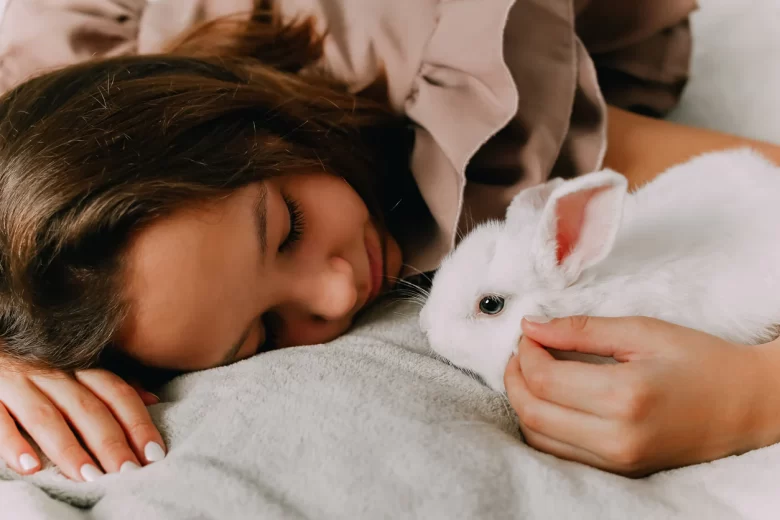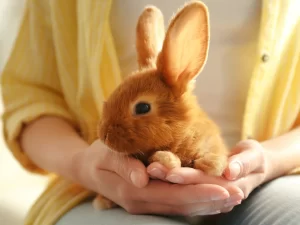Rabbits make great pets and are very smart. They bring happiness to many families around the world. However, if you want to develop a good relationship with your rabbit, you need to understand and manage its behavior. This book is designed to help you understand rabbit behavior and train them in a way that keeps you and your rabbit happy and healthy.
Discover the Behavior of Rabbits
- Social Animals: Rabbits are very social and love to be around other rabbits. In the wild, they live in groups called ‘packs’. As pets, they often form close bonds with the people who care for them and with other rabbits. It’s important to spend quality time with your rabbit to meet his social needs.
- Communication: Rabbits talk to each other by banging, moving their bodies, and making sounds. To understand how they feel, you need to know their signals. For example, a calm rabbit may purr softly, while a thumping rabbit may show fear or warn of possible danger.
- Biting and poking: Rabbits naturally enjoy biting and poking. Making this behavior something fun, such as chewing toys and digging in boxes, can help prevent them from becoming bad habits. Be careful with electrical cords and other household items that can be easy targets.
- Territorial Instincts: Rabbits can be very possessive and mark their territory by rubbing their chins or spraying water. Neutering a rabbit can cause it to no longer be protective and aggressive.
Basics of Training
- Positive Reinforcement: To get people to behave well, positive reinforcement can be used. When your rabbit does something nice, such as quietly using the litter box or staying while you are working with him, give him his favorite treat or lots of love.
- Clicker Training: Clicker training is a great way to do this if you want to teach your rabbit new habits. By placing the treat along with the clicking sound, your rabbit can begin to associate the clicking sound with the treat, making it easier to learn good behavior.
- Litter training: You can teach most rabbits to use a litter box, which makes it easy for them to keep their living space clean. Place a litter box in one part of the cage. Give them a treat and praise them when they use it.
- Treat and Connect: To build a good relationship, it is important to build trust by treating the other person in a kind and consistent manner. Before you try to pick up your rabbit, go slowly and give him time to get used to you. Gradually increase the duration of treatment sessions.
Dealing With Common Behavioral Problems
- Aggression: Rabbits may show aggression due to fear, the need to protect their territory, or hormonal changes. Talk to your vet to rule out health problems and consider having your pet spayed or neutered. Adjusting slowly to new places and people can also help reduce anger.
- Destructive Chewing: Give your rabbit a variety of safe chew toys to change the way he naturally chews. If you don’t want your rabbit to chew on unsafe things, make sure he has plenty of mental and physical activity to do.
- Digging: If your rabbit likes to dig, prepare a special area for him with soft materials such as shredded paper or hay. This gives them what they want without damaging the carpet or chairs.
- Spraying: Rabbits that have not yet been neutered can be sprayed to mark their area. Spaying or neutering your pet can make this trait less noticeable. By regularly cleaning and neutralizing the marked areas you prevent people from spraying there again.
Conclusion
By learning and respecting your rabbit’s natural behavior, you can calm your rabbit’s living space and strengthen your bond with your pet. To eliminate common problems and develop good habits, you must be patient, use positive reinforcement, and train your pet consistently. Remember that every rabbit is different, so make sure you treat them in a way that suits their attitude and tastes. With some effort and time, you and your rabbit can have a happy and satisfying relationship.
FAQs
1. What are the signs that a rabbit is happy?
Happy rabbits can slowly groom themselves, purr, do binky hops (happy hops), and rock their bodies back and forth, all of which indicate that they are happy. A healthy appetite, clear eyes, and a generally alert attitude are also good signs.
2. How do I get my rabbit used to a new place or new people?
It’s important to introduce new places or people slowly. Let your rabbit walk around and explore at his speed. Scent exchange, which means exchanging things between rabbits, is a great way to get them familiar with each other before they meet. Watch the first round of conversations and wait your turn.
3. Why does my rabbit dig or chew too much?
Rabbits naturally do things like chewing and digging. Provide them with a range of safe chew toys and places to dig to satisfy their natural desires. If your rabbit chews or digs too much, it’s probably because he’s bored. Make sure he gets enough mental and physical exercise.
4. How do I teach my rabbit to use the outdoor bathroom?
Placing a litter box in the corner of your rabbit’s cage is part of toilet training. When your rabbit uses the box, praise and reward him. The key is consistency and good reinforcement. Do not use clumping cat litter as it can be dangerous if your cat eats it.
5. What is clicker training? How do I teach my rabbit to use clicker training?
For clicker training, you can use a gadget that makes a distinct clicking sound. To get people to do what you want, you can link clicks to rewards. After giving your rabbit a treat, click when he does what you want. This can help your rabbit learn that clicks mean good things.
6. My rabbit is acting hostile. what should I do?
Rabbits can become vicious when they are afraid, protecting their territory, or undergoing hormonal changes. Consult your doctor to make sure you don’t have any medical problems. Spaying or neutering your pet can help reduce its aggression. Aggressive habits can also be corrected by slowly introducing them to people and places and rewarding good behavior.


